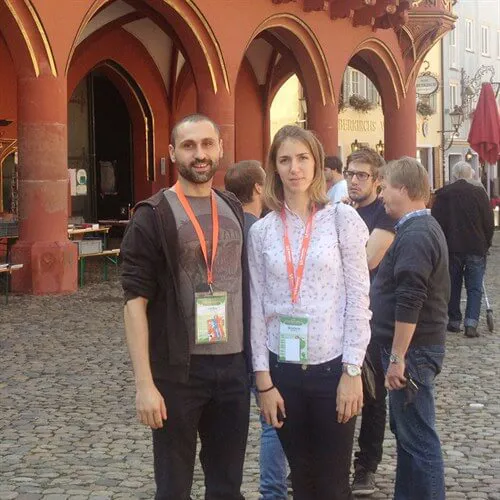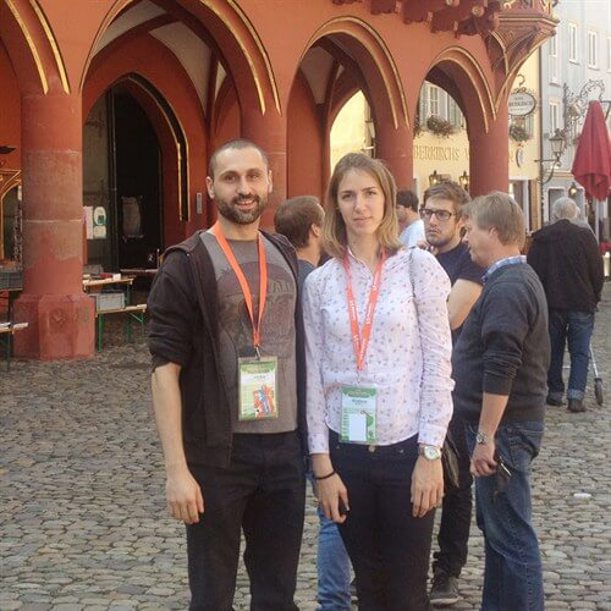Smashing Conference, Freiburg 2014

- Two days, eighteen magnificent speakers
- Practical and useful talks
- 300 attendees
Speeches given on the first day of the Smashing Conference 2014 in Freiburg were once again very interesting and instructive.
GOOD IS THE ENEMY OF GREAT by Marcin Wichary
Marcin spoke about designing and then understanding the perfect underline.
Finding the perfect underline
"The perfect underline should be visible, but unobtrusive - allowing people to realize what's clickable, but without drawing too much attention to itself. It should be positioned at just the right distance from the text, sitting comfortably behind it for when descenders want to occupy the same space."
Where things get complicated
"Figuring out how to position one underline perfectly and test it on major browsers seemed like a nice, fast evening project."
And then, it happens
"There's something anticlimactic about finishing a long code review. There are no fireworks, no champagne; GitHub doesn't change the UI in any celebratory way to highlight your achievement. After 31 days of discussions, trials and errors, and trying many approaches, both of my great reviewers sent the magic four letters: LGTM."

DESIGN CONSISTENCY FOR THE RESPONSIVE WEB by Patty Toland
It is difficult for a 12 column grid to function when you have to optimize it for so many different device-widths. It is better to have a simple grid, even for complex modules.
Design consistency is not about pixels, design consistency is about purpose.
"Responsive Webdesign is more than fitting stuff on screens." - Patty Toland
Responsive web design speed problems:
- Images
Third party tools (advertising, social media, tracking)
Frameworks
Network
Tips:
- In RWD, first make sure it's readable and that interactive areas have enough separation
from other controls. - Render something useful as quickly as possible.
- For Impatient Web Users, an Eye Blink Is Just Too Long to Wait
The second day on the conference was also very inspiring. This year also featured a mystery speaker.
CSS ARCHITECTURE by Dave Shea
I was honored to be present and listen to Dave Shea. Dave Shea is a Canadian web designer and co-author of The Zen of CSS Design: Visual Enlightenment for the Web.
Dave spoke about a CSS architecture system called Argon. A bloated code base was the problem, whereas the solution was the development of a CSS architecture system. The main principles of Argon are:
- No IDs
- Classes only. Not even HTML elements are styled
- .component.-modifier ._descendent
- Exception: .js prefix for classes that are there only for JS. May not be styled.
- It is not important which syntax you used. What is important is that you stick to it.
- Objectives of the new architecture are: predictability, reusability, modularity and team-wide consistency.
ORCHESTRATING CONTENT by Sara W.-Boettcher
Instead of planning pages, now we're asking stakeholders to prioritize and manage a million bits of modular content.
So how do we keep our subject-matter experts from feeling overwhelmed, prevent carousel-obsessed executives from endless homepage arguments, and get the content we need to make design and development decisions?
The answer is in using content strategy as a means to orchestrate, not dictate.
Content on mobile should not be simply adapted only in design to the resolution, but may also be reconsidered. Maybe it makes sense to divide the content into individual chunks.
Content planning has already happened at the beginning of the project and the designer and developer should be involved in it.
Limit time and give workshop participants a form to answer important questions:
- Who are we?
Who is our audience?
What are our goals?
How should we sound?
How could things be better?
BE ALL IN WITHOUT CHECKING OUT by Phil Coffman
Try to be the best and to learn continuously, but the balance with family and leisure time is important.
- be careful of overindulging in inspiration
- choose employers wisely
- establish and communicate work boundaries
- know When to fight and When to concede
- Social Media & Community: A focused period of motivated production
- plan the future
- try to find balance between good work and life.


